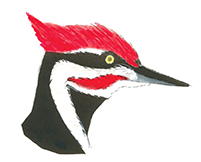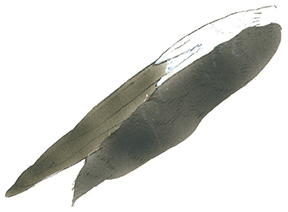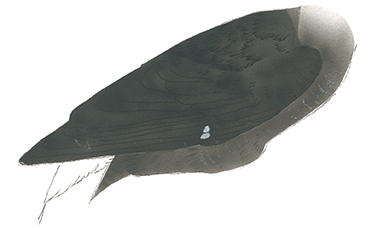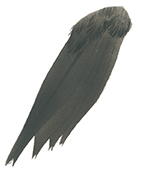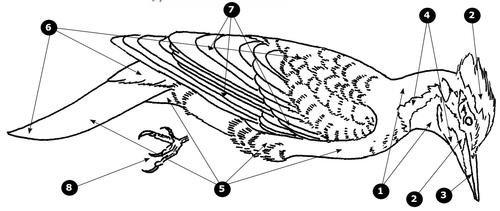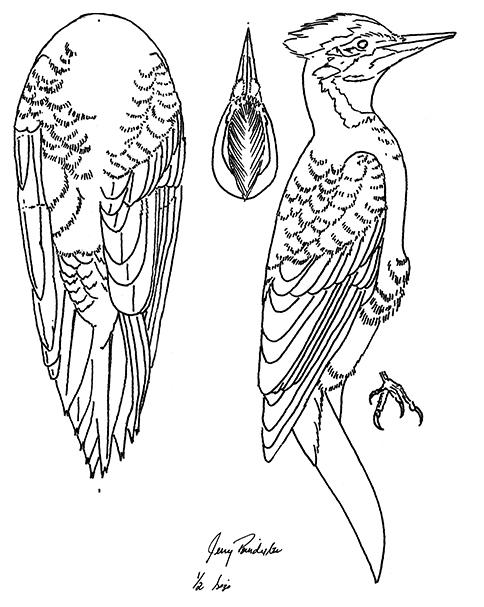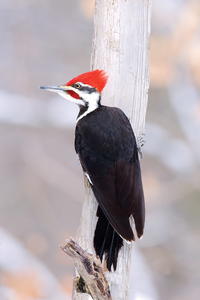Pileated Woodpecker
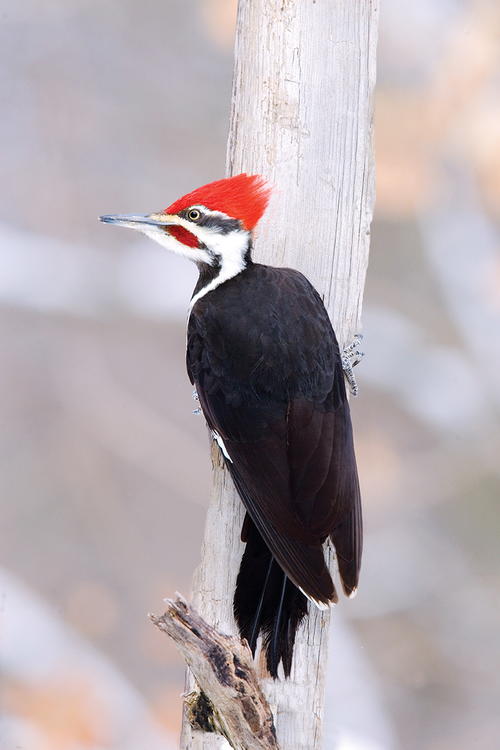
The pileated woodpecker (Dryocopus pileatus) is our largest woodpecker (although the ivory-billed woodpecker, now presumed extinct, was larger). It measures between 15 and 19 inches in length. Pileated woodpeckers have black to slate-black plumage with white and red markings. The head has a conspicuous bright red crest and malar (mustache). The long bill is black. These birds will nest in cavities in dead trees 15 to 70 feet high.
The reference for the pattern and painting notes were study skins provided by Eastern Washington University in Cheney, Washington. The male pileated woodpecker will be the “Best in the Northwest” species at the 2020 Columbia Flyway Show in Vancouver, Washington, in September. (The bird for 2021 will be the ruby-crowned kinglet.)
Supplies
Liquitex
• White gesso
• Titanium white
• Burnt umber
• Burnt sienna
• Ultramarine blue
• Cadmium red medium
• Napthol crimson
Jo Sonja
•Warm white
•Ultramarine blue deep
•Payne’s gray
•French blue
•Dioxazine purple
M. Graham & Co
•Mars black
Having been able to observe the plumage of study skins, one within an hour of death, I found there are only slight variations in the black. You could almost paint the pileated woodpecker with just black, red, and white. Applying different values of colors will make your painting more interesting.
The base color for all the black areas (except upper-tail feathers) is 1 part Mars black, 1 part warm white, and 2 parts raw umber.
PAINT SWATCHES
-
1 part burnt sienna;
2 parts Mars black -
1 part Mars black;
1 part warm white;
2 parts raw umber -
Equal parts ultramarine blue and burnt umber
-
1 part burnt umber;
2 parts Mars black -
Equal parts ultramarine blue deep with burnt sienna and a touch of dioxazine purple
-
Equal parts ultramarine blue and burnt umber with a touch of warm white
-
1 part burnt umber;
1 part Payne’s gray;
touch of Mars black -
Equal parts French blue, burnt umber, and white gesso
-
Equal parts red medium and napthol crimson
PARTS
-
HEAD (BLACK AREA)
Apply 1 part burnt sienna with 2 parts Mars black. Be careful not to get black in the red crest and malar areas.
HEAD CREST AND MALAR (MUSTACHE)
Apply a base color of cadmium red medium. Once this dries, apply equal parts of cadmium red medium and napthol crimson -
BILL
For the upper mandible, apply equal parts of burnt umber and Payne’s gray with a touch of Mars black. For the lower mandible, mix equal parts of French blue, burnt umber, and white gesso. Blend more white toward the base of the bill. Make the tips of the mandibles darker. -
THE WHITE STRIPES OF THE HEAD, BREAST, AND PRIMARY FEATHERS
Apply warm white, pulling the white into the black and the black into thewhite areas.
UNDER WINGS
Apply 1 part Mars black and 2 parts raw umber with a touch of warm white. Near the wrist, the feathers and marginal feathers are warm white -
Under-tail feathers and under-tail coverts; belly, breast, and wings
Apply equal parts of ultramarine blue and burnt umber with a touch of warm white, and darken the ends of all feathers and beside each feather to show separation. The sides of the breast feathers and the flanks are terminally margined with warm white. The base of the primary feathers right behind the primary coverts have a distinct marking of warm white. -
Upper-tail feathers, coverts, and mantle
Apply 1 part burnt umber with 2 parts Mars black. These areas appear especially black. To create that look, detail the edges of each feather with ultramarine blue deep with a touch of dioxazine purple. Pull this color toward the bases. -
Primary and secondary feathers (tertials), primary, greater, median, lesser coverts and alula feathers.
Use equal parts ultramarine blue and burnt umber. -
Tarsus and feet
The tarsus and feet are equal parts ultramarine blue and burnt umber with interspaces of a pale gray or white. Apply a grayish mix of equal parts French blue, burnt umber, and gesso.
MEASUREMENTS (half-size, in mm)
Eyes: 4 (cream yellow)
Wing chord: 115 (from the wrist to the longest primary feather)
Head width at the ear coverts: 17.5
Bill:
•Tip of the bill to the front of the eyes: 31
• Exposed culmen: 24
• Gape: 28 Width: 9.5
• Bottom: 13
Nares:
•18; width: 7; Height: 6.5
Malar: 20.5
Tarsus: 21 Visible: 7.5
Width: 1.75 Height: 2
Toes:
• Hallux: 4.5 (plus 5 for nail)
• Middle: 12.5 (plus 7.5)
• Inner: 7 (plus 7)
•Outer: 11.5 (plus 7)
Tail length (visible): 71
Pileated Woodpecker
Pileated Woodpecker
By Jerry Poindexter © 2019
-
Note to professional copying services: You may make up to 10 copies of this pattern, without the express written permission of Wildfowl Carving Magazine, for any purchaser who states that the copies are for personal use.
Jerry Poindexter is a carving judge and the author of Songbirds I and II (measured drawings, containing 50 patterns). You can reach Jerry via e-mail at icarve@cet.com.
Read NextOlive Warbler


